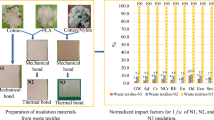Abstract
Part 2 summarises the results of a comparative LCA study of HT stone wool, flax representing crop grown products and paper wool representing recycled products applied for roof insulation, in which an attempt is made to answer the question of whether the biological products flax and paper wool are more environmentally preferable than the mineral product stone wool representing more traditional insulation materials. Of the three products compared, paper wool has, in general, the lowest global and regional environmental impacts and flax insulation the highest, with stone wool falling in between. A notable exception is the total energy use, where stone wool has the lowest consumption, followed by cellulose and flax. The study also addresses occupational health, using an approach similar to that used for risk assessment. Here, the modern less biopersistent stone wool products are seen as the safest alternatives, because of a low potential for exposure, sufficient animal testing and the absence of carcinogenic properties. Overall, the differences between the investigated products are of minor environmental significance compared to that achieved by their use, namely insulation of buildings, which saves energy corresponding to more than 100 times the environmental impacts incurred in their manufacture. The main conclusion is that the quality and fitness for use of an insulation product throughout its useful life span is the most important aspect in the life cycle of insulation materials.
Similar content being viewed by others
References
Bowdidge J (1998): Life cycle inventory assessment for Rockwool Limited for 1996. Rollbatts loft insulation thickness 150 mm. Pencoed, Bridgend, UK: Rockwool Limited (Unpublished)
Weill H, Hughes J (1996): Review of epidemiological data on morbidity following exposure to man-made vitreous fibers. J Occup Health Safety — Aust NZ 12, 319–325
IARC (2002). Monographs on the Evaluation of Carcinogenic Risks to Humans. Vol. 81, Man-made Vitreous Fibers. Lyon: International Agency for Research on Cancer
Davis JMG (1989): Experimental data relating to the importance of fiber type, size, deposition, dissolution, and migration. In: Non-occupational Exposure to Mineral Fibers. Bignon J, Peto J, Saracci R, Eds. IARC Scientific Publications 90, 33-45. Lyon: International Agency for Research on Cancer
Kamstrup O, Ellehauge A, Chevalier J, Davis JMG, McConnell EE, Thévenaz P (2001): Chronic inhalation studies of two types of stone wool fibers in rats. Inhal Toxicol 13, 603–621
Guldberg M, Jensen SL, Knudsen T, Steenberg, T, Kamstrup O (2002): High-alumina low-silica HT stone wool fibers: A chemical compositional range with high biosolubility. Regul Toxicol Pharmacol 35, 217–226
Kamstrup O, Ellehauge A, Collier CG, Davis JMG (2002): Carcinogenicity studies after intraperitoneal injection of two types of stone wool fibers in rats. Ann Occup Hyg 46 (2) 135–142
Breum NO, Schneider T, Flyvholm MA, Jørgensen O, Rasmussen TV, Eriksen SS(2002): Luftforureninger ved anvendelse af alternative isoleringsmaterialer. AMI Rapport 57. Copenhagen, Denmark: National Institute of Occupational Health
Cullen RT, Miller BG, Clark S, Davis JMG (2002): Tumorigenicity of cellulose fibers injected into the rat peritoneal cavity. Inhal Toxicol 14, 585–703
Hadley J, Kotin P, Bernstein D (1992): Sub-acute (28 days) repeated dose inhalation toxicity of cellulose building insulation in the rat. Paper presented at the US Society of Toxicology Conference, Seattle, 11th February 1992
Muhle H, Ernst H, Bellman B (1997): Investigation of the durability of cellulose fibers in rat lungs. Ann Occup Hyg 41, 184–188
Parkes R (1994): Occupational lung disorders. Oxford: Butterworth-Heinemann Ltd.
Author information
Authors and Affiliations
Corresponding author
Rights and permissions
About this article
Cite this article
Schmidt, A.C., Jensen, A.A., Clausen, A.U. et al. A comparative life cycle assessment of building insulation products made of stone wool, paper wool and flax. Int J LCA 9, 122–129 (2004). https://doi.org/10.1007/BF02978571
Received:
Accepted:
Issue Date:
DOI: https://doi.org/10.1007/BF02978571




